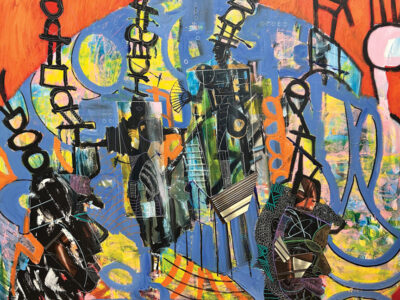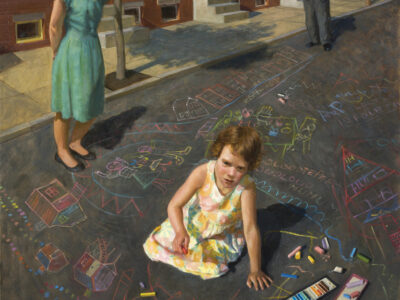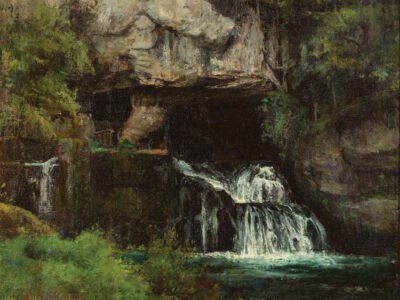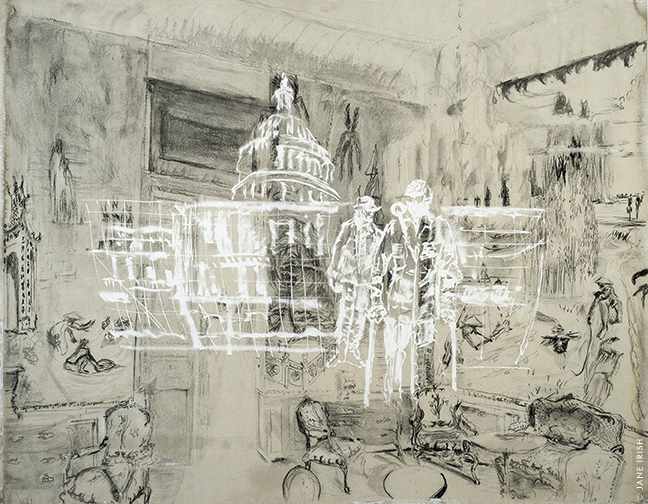
Dewey Canyon III Drawing
The subject was painting, specifically the political kind.
“You have to make it so people want to look at it,” Jane Irish was saying. “I mean, I love the idea of being somewhat seductive.” She let out a gleeful laugh. “The more beautiful it is, the more people will look at it.”
That approach serves goals that are both subversive and lofty, and it represents just one of many alternating currents pulsing through Irish, who has served as coordinator of Penn’s MFA program for the past 16 years and is stepping down at the end of the semester. The duality is most evident in the way she harnesses the disparate energies and skills required to make eye-seducing, thought-provoking fine art by night while shepherding dozens of graduate students through the MFA program by day.
“I look up to her as an example of how an artist can balance the needs of a full-time job and also develop a serious studio practice outside of it,” says Kelsey Halliday Johnson GFA’12, a former student of Irish’s who is now assistant curator at Locks Gallery in Philadelphia, where an exhibition of Irish’s works just closed.
The benefits have flowed both ways. “Penn was a great place” for someone who needed to balance those needs, says Irish. “It’s wonderful being around young artists, learning what’s contemporary every day in the field, being around amazing faculty and visiting artists.”

Vet Center Vase
There is also the form-shifting involved in adapting to different media, which in recent years has included more and more of her delicate, subversively decorated vases and other ceramic works.
“Each medium holds its own possibilities for how Jane can explore the stories she wants to tell, the symbolism she explores, and the history of decorative arts she is so engaged with,” says Johnson. “Having a group of faculty and staff that are all practicing interdisciplinary artists—like Jane—is what allowed the Penn MFA program to reinvent itself starting in 2010 and go in a new direction.”
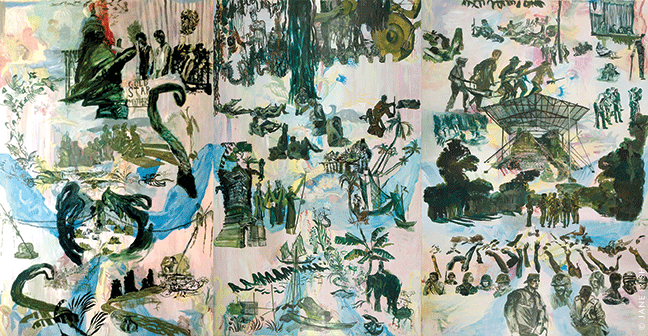
Boiserie
Trained as a painter at a time when many art schools took a “sort of French delight in painterly presentation and representation,” Irish says that she always saw herself as a conceptual artist, inspired by the likes of Bruce Nauman and Vito Acconci. Which leads to another duality within her work: the scenes of war and protest and resistance that infiltrate her luminous, seemingly playful interiors of French drawing rooms and Italian palazzi. (Think Going After Cacciato or In Country as dreamed by Toulouse-Lautrec.)
“I’ve always had a sort of social consciousness to my painting,” says Irish, who notes a number of artistic turning points in her career. “In 1989, I saw a lot of shows about the French Revolution, and just seeing what artists were doing at a time of political upheaval—which artists were still painting for the Academie [des Beaux-Arts] or the Salon [de Paris], and which were painting political work—kind of excited me.”
As she traveled through Europe to look at porcelain, she found that many of the porcelain museums were located in the same towns as French Resistance museums. When she returned to the States and wanted to research the Resistance in the library, she often found herself looking at a nearby subcategory: Resistance, Draft.
“I said, ‘Oh, right! I know about Draft Resistance—I grew up with that,’” Irish recalls. “It was sort of a weird linguistic thing, but I was really looking to find some kind of meaning to my work that would take me beyond the formal—a real calling that would commemorate something that I cared about. So I started to think about the ’60s, and the Resistance period during and after the Vietnam War, and started painting things about it.”
As she focused on the “positive signs of resisting, to commemorate the people who stood up,” her work often centered on Vietnam Veterans Against the War, which Irish sees as representing “people from within the system that served but had the strength to change, or the strength to resist.”
Starting in 2008, Irish traveled three times to Vietnam, where her work drew on literary imagery (from Tim O’Brien’s war novels to the 18th-century poetry of Ho Xuan Huong) and landscapes ranging from rural Buddhist temples to the Perfume River in Hué. She returned from each visit with about 20 significant paintings, many of which she incorporated into larger works.
Irish wasn’t through with Europe, though. After gaining entrée to private houses in Brittany, where she painted interior scenes of parlors, she found herself creating similarly luscious images inside the palazzi of the Medici in Florence. Her forays into the world of ceramics have led to a style that is at once “high French” and accessibly American—much of it, again, infused with motifs of Vietnam.
“By somehow painting the beauty of this country that we managed to defoliate, it’s just leading me in the direction of something beautiful and positive, but also conscious,” she says. “At the same time, I’m still continuing with the Resistance motifs. It’s getting a little more mythic. When we think of the Vietnam War, we think of motifs like Rambo or the Eddie Adams photo of the burning napalm [girl]. What if the artist’s work was strong enough that it could replace that?” —S.H.


